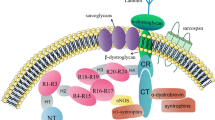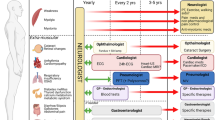Abstract
Spinal muscular atrophy (SMA) is a neurodegenerative disease resulting from decreased levels of survival motor neuron 1 (SMN1) protein. Reduced SMN1 levels are linked to pathology at neuromuscular junctions (NMJs), which includes decreased vesicle density and organization, decreased quantal release, increased endplate potential duration, and neurofilament (NF) accumulations. This work presents a first study towards defining molecular alterations that may lead to the development of NMJ pathology in SMA. Fast, anterograde transport of synaptic vesicle 2 (SV2-c) and synaptotagmin (Syt1) proteins was reduced 2 days prior to the observed decrease in synaptic vesicle density. Moreover, reduced accumulation of SV2-c or Syt1 was not due to reduced protein expression or reduced kinesin activity. Dynein levels were reduced at times that are consistent with NF accumulations at NMJs. Furthermore, NF distribution, from cell body to sciatic nerve, appeared normal in SMA∆7 mice. Taken together, these results suggest that reduced axonal transport may provide a mechanistic explanation for reduced synaptic vesicle density and concomitant synaptic transmission defects, while providing evidence that suggests NF accumulations result from local NMJ alterations to NFs.







Similar content being viewed by others
References
Bocquet A, Berges R, Frank R et al (2009) Neurofilaments bind tubulin and modulate its polymerization. J Neurosci 29:11043–11054
Buckley K, Kelly RB (1985) Identification of a transmembrane glycoprotein specific for secretory vesicles of neural and endocrine cells. J Cell Biol 100:1284–1294
Cifuentes-Diaz C, Nicole S, Velasco ME et al (2002) Neurofilament accumulation at the motor endplate and lack of axonal sprouting in a spinal muscular atrophy mouse model. Hum Mol Genet 11:1439–1447
Gabanella F, Butchbach ME, Saieva L et al (2007) Ribonucleoprotein assembly defects correlate with spinal muscular atrophy severity and preferentially affect a subset of spliceosomal snRNPs. PLoS One 2:e921
Garcia ML, Rao MV, Fujimoto J et al (2009) Phosphorylation of highly conserved neurofilament medium KSP repeats is not required for myelin-dependent radial axonal growth. J Neurosci 29:1277–1284
Hanlon DW, Yang Z, Goldstein LS (1997) Characterization of KIFC2, a neuronal kinesin superfamily member in mouse. Neuron 18:439–451
Higuchi M, Lee VM, Trojanowski JQ (2002) Tau and axonopathy in neurodegenerative disorders. Neuromolecular Med 2:131–150
Jung C, Lee S, Ortiz D et al (2005) The high and middle molecular weight neurofilament subunits regulate the association of neurofilaments with kinesin: inhibition by phosphorylation of the high molecular weight subunit. Brain Res Mol Brain Res 141:151–155
Kamal A, Stokin GB, Yang Z, Xia CH, Goldstein LS (2000) Axonal transport of amyloid precursor protein is mediated by direct binding to the kinesin light chain subunit of kinesin-I. Neuron 28:449–459
Kanai Y, Okada Y, Tanaka Y et al (2000) KIF5C, a novel neuronal kinesin enriched in motor neurons. J Neurosci 20:6374–6384
Kariya S, Park GH, Maeno-Hikichi Y et al (2008) Reduced SMN protein impairs maturation of the neuromuscular junctions in mouse models of spinal muscular atrophy. Hum Mol Genet 17:2552–2569
Kong L, Wang X, Choe DW et al (2009) Impaired synaptic vesicle release and immaturity of neuromuscular junctions in spinal muscular atrophy mice. J Neurosci 29:842–851
Lazarov O, Morfini GA, Pigino G et al (2007) Impairments in fast axonal transport and motor neuron deficits in transgenic mice expressing familial Alzheimer’s disease-linked mutant presenilin 1. J Neurosci 27:7011–7020
Le TT, Pham LT, Butchbach ME et al (2005) SMNDelta7, the major product of the centromeric survival motor neuron (SMN2) gene, extends survival in mice with spinal muscular atrophy and associates with full-length SMN. Hum Mol Genet 14:845–857
Monani UR, Coovert DD, Burghes AH (2000) Animal models of spinal muscular atrophy. Hum Mol Genet 9:2451–2457
Monani UR, Sendtner M, Coovert DD et al (2000) The human centromeric survival motor neuron gene (SMN2) rescues embryonic lethality in Smn(−/−) mice and results in a mouse with spinal muscular atrophy. Hum Mol Genet 9:333–339
Murray LM, Comley LH, Thomson D et al (2008) Selective vulnerability of motor neurons and dissociation of pre- and post-synaptic pathology at the neuromuscular junction in mouse models of spinal muscular atrophy. Hum Mol Genet 17:949–962
Pearn J (1978) Incidence, prevalence, and gene frequency studies of chronic childhood spinal muscular atrophy. J Med Genet 15:409–413
Pellizzoni L, Kataoka N, Charroux B, Dreyfuss G (1998) A novel function for SMN, the spinal muscular atrophy disease gene product, in pre-mRNA splicing. Cell 95:615–624
Rigaud M, Gemes G, Barabas ME et al (2008) Species and strain differences in rodent sciatic nerve anatomy: implications for studies of neuropathic pain. Pain 136:188–201
Rose FF Jr, Mattis VB, Rindt H, Lorson CL (2009) Delivery of recombinant follistatin lessens disease severity in a mouse model of spinal muscular atrophy. Hum Mol Genet 18:997–1005
Rose FF Jr, Meehan PW, Coady TH et al (2008) The Wallerian degeneration slow (Wld(s)) gene does not attenuate disease in a mouse model of spinal muscular atrophy. Biochem Biophys Res Commun 375:119–123
Ruiz R, Casanas JJ, Torres-Benito L, Cano R, Tabares L (2010) Altered intracellular Ca2+ homeostasis in nerve terminals of severe spinal muscular atrophy mice. J Neurosci 30:849–857
Seiler S, Kirchner J, Horn C et al (2000) Cargo binding and regulatory sites in the tail of fungal conventional kinesin. Nat Cell Biol 2:333–338
Sumner CJ, Huynh TN, Markowitz JA et al (2003) Valproic acid increases SMN levels in spinal muscular atrophy patient cells. Ann Neurol 54:647–654
Young SM Jr, Neher E (2009) Synaptotagmin has an essential function in synaptic vesicle positioning for synchronous release in addition to its role as a calcium sensor. Neuron 63:482–496
Zhang Z, Lotti F, Dittmar K et al (2008) SMN deficiency causes tissue-specific perturbations in the repertoire of snRNAs and widespread defects in splicing. Cell 133:585–600
Zhao C, Takita J, Tanaka Y et al (2001) Charcot–Marie–Tooth disease type 2A caused by mutation in a microtubule motor KIF1Bbeta. Cell 105:587–597
Zheng YL, Li BS, Veeranna PantHC (2003) Phosphorylation of the head domain of neurofilament protein (NF-M): a factor regulating topographic phosphorylation of NF-M tail domain KSP sites in neurons. J Biol Chem 278:24026–24032
Acknowledgments
This work was supported by Grants from National Institutes of Health [Grant number NS060073] and Charcot-Marie-Tooth Association [Grant number C00014627] and University of Missouri Research Board to MLG and by Grants from National Institutes of Health [Grant numbers R01HD054413 and R01NS041584] to CLL. Salary support for MLG was provided by the University of Missouri-Columbia and the C.S. Bond Life Sciences Center. JMD was supported by an ARRA supplement to T32 GM008396. HS was supported by Charcot-Marie-Tooth Association [Grant number C00014627] to MLG. DMB was supported by both the C.S. Bond Life Sciences Fellowship Program and the Graduate Assistance in Areas of National Need Fellowship Program. We thank the following: Electron Microscopy Core Facility at the University of Missouri for assistance with tissue preparation and with electron microscopic analysis, Mr. Steve Lamont for writing the scripts used in automated determination of numbers of NFs in assigned groups for nearest neighbor distance profiles, and Dr. Emmanual Liscum and Dr. David Schulz for comments and insights that improved this manuscript.
Conflict of interest
None.
Author information
Authors and Affiliations
Corresponding author
Rights and permissions
About this article
Cite this article
Dale, J.M., Shen, H., Barry, D.M. et al. The spinal muscular atrophy mouse model, SMAΔ7, displays altered axonal transport without global neurofilament alterations. Acta Neuropathol 122, 331–341 (2011). https://doi.org/10.1007/s00401-011-0848-5
Received:
Revised:
Accepted:
Published:
Issue Date:
DOI: https://doi.org/10.1007/s00401-011-0848-5




